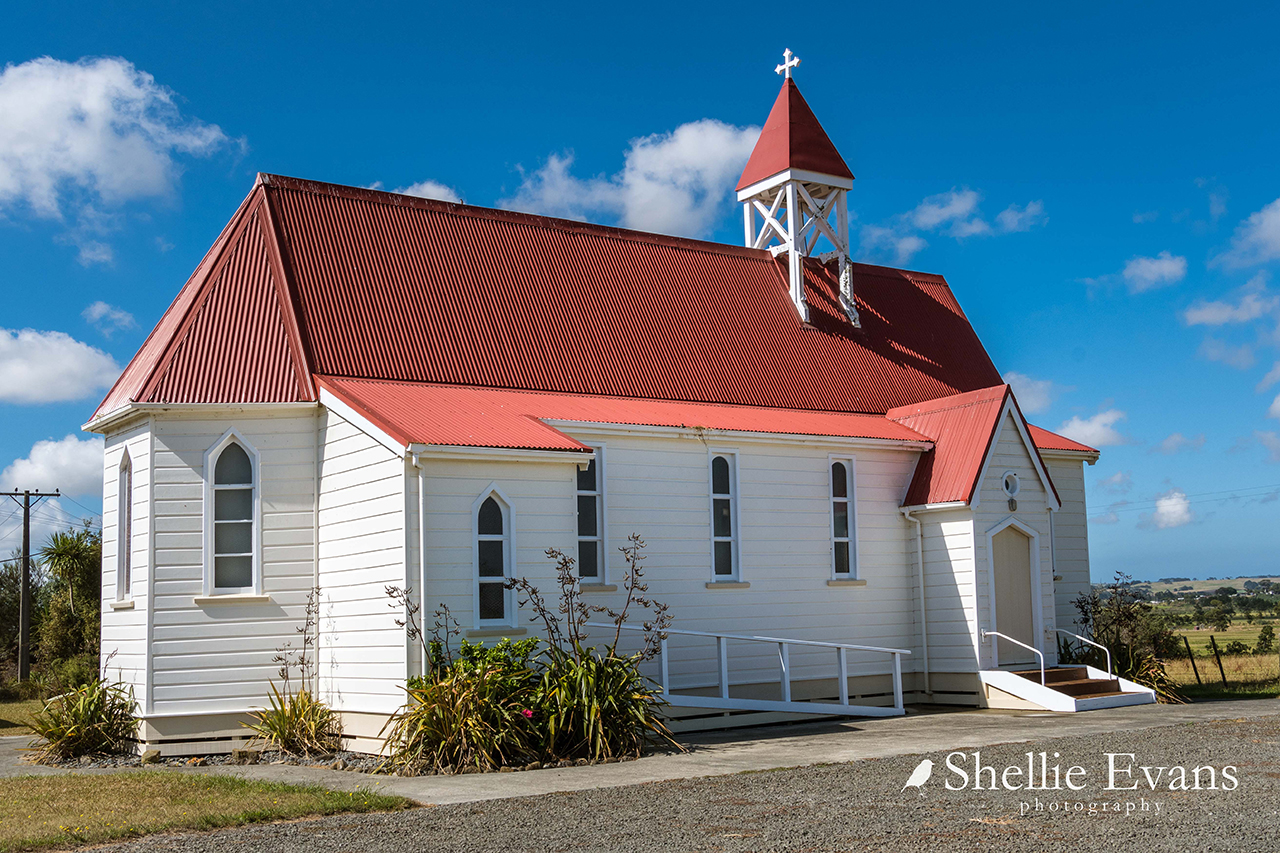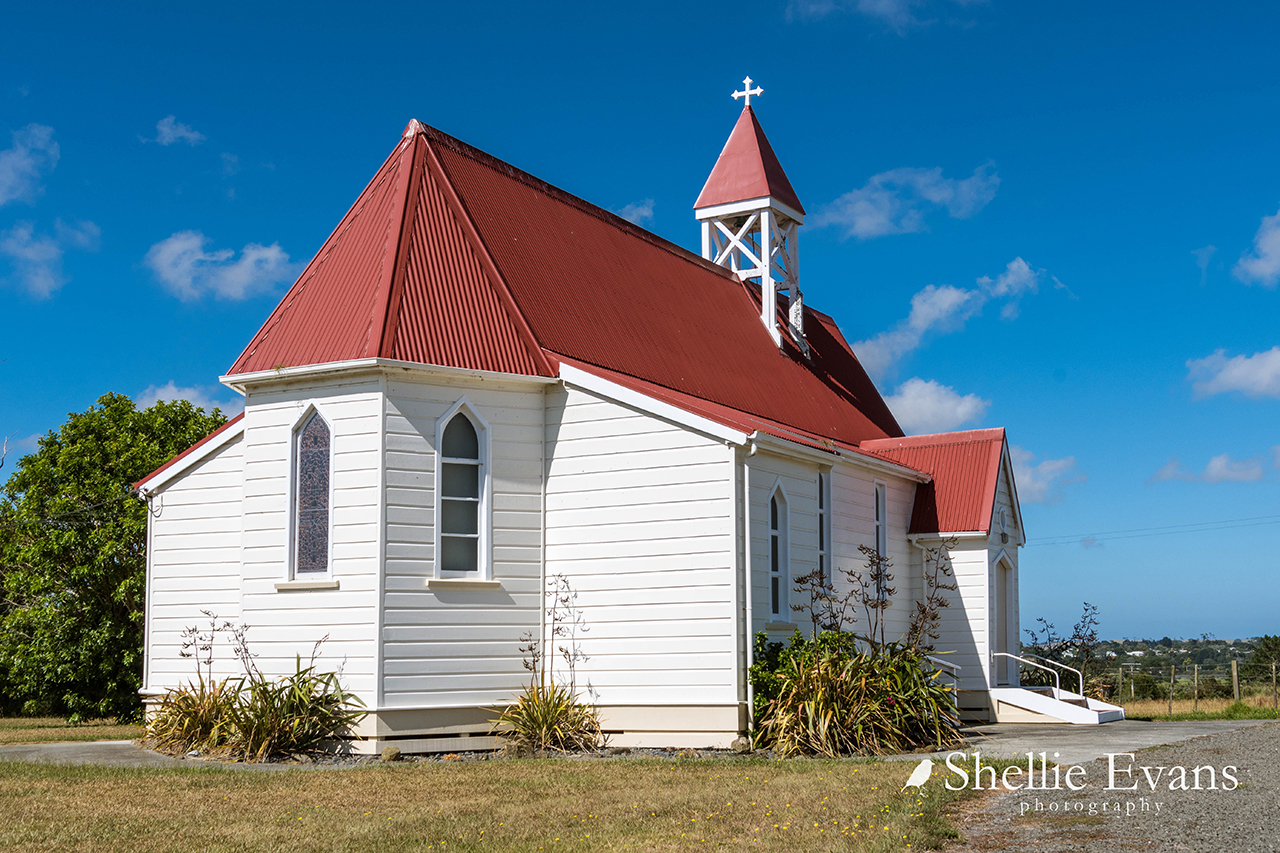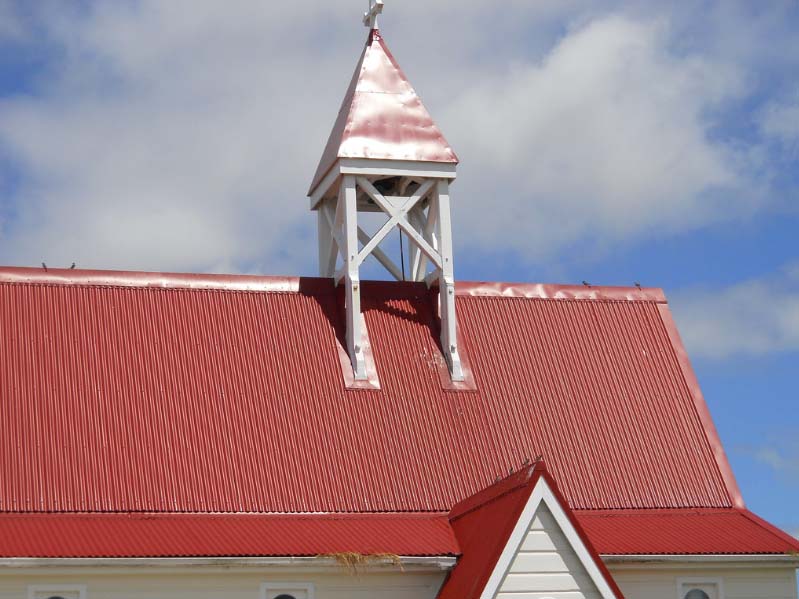Relocated to Mititai in 1922, All Saints' Parish Church was originally constructed by the Anglican congregation of Aratapu and opened for worship there in December 1883. Aratapu, now almost a ghost town on the western bank of the Wairoa River south of Dargaville, was once busy and thriving, the busiest sawmilling centre on the River. Three large mills operated, employing 140 to 150 hands. All steamers running between Helensville and Dargaville called in at Aratapu. The first large mill opened in 1865, but business took a major leap forward when the Kauri Timber Company began business there in 1888. At its peak 250,000 feet of timber a week was milled. There was an active Anglican congregation in the Aratapu area in the 1870s. Services were held every Sunday in the public hall. In 1882 plans began to build a permanent church. The Church Gazette of March 1882 reported that drawings, plans and specifications had been drawn up for 'a pretty Church, to seat 150 worshippers'. This preparatory work was done by the Reverend P. Walsh of Waitara, who donated it to the Aratapu congregation. Efforts were then begun to raise money for the building. In July 1882 the building fund stood at £155, a large amount of money but well short of the estimated £380 required. Fundraising was no easy task. The community was almost entirely made up of workingmen on meagre weekly wages, many of whom were transient, seasonal workers with no strong attachment to the district. The committee therefore broadcast its appeal more widely, soliciting 'the assistance of Christian people possessed of larger means'. Construction started by the end of 1882. Built by W.A. Spiers, All Saints' Church, Aratapu was opened on Tuesday evening, 11 December 1883. The building was unfurnished, and it was not debt-free. Bishop Cowie promised that when the building was furnished and free of debts, he would be glad to consecrate it. The opening of the church is said to have been a joyous affair. The church bazaar, held over the next two days, featured six stalls, draped with blue and pink and adorned with curtains. Many people from Dargaville and Mangawhare attended, travelling down the river. In the evening the public was entertained by the Fife and Drum Band and the Glee Club. In the early 1900s the sawmills at Aratapu meant that the church served a large, thriving community of two thousand people. But the flourishing growth of the church contained the seeds of its own decay. In 1902, the same year that a stone font was installed in All Saints', St Peter's Church was opened in nearby Te Kopuru, to service the large community that had grown up around the sawmill there. Some parish¬ioners who might have come to Aratapu now chose to attend church at Te Kopuru. At the same time the sawmills at Aratapu began to decline. As the mills closed, the population dispersed, and support for All Saints' Church fell away. It was apparently closed and abandoned somewhere around 1918: it seems to have declined so much in importance that even the date of its closure has not been recorded. In November 1919 parishioners in Mititai across the Wairoa River from Aratapu obtained Diocesan approval to build a stone church. The Building Committee subsequently abandoned plans for a stone church, and decided instead to investigate the possibility of removing the disused church building from Aratapu to Mititai. In February 1921 the Anglican General Trust Board gave its consent to the proposal. Mititai was another riverside settlement with its origins in timber milling, containing the site of the second mill established in the Northern Wairoa, opened in 1865. In the 1920s, the road between Dargaville and Matakohe through Mititai - now State Highway 12 - was improved, connecting the settlement more effectively to other parts of the district. The new site was land donated by parishioner Robert Montgomery. The task of moving the church building by land and river to its present site was undertaken by Brown and Sons, overseen by their foreman Mr E.E. Burgess, in February 1922: The building was loaded on three barges. We had to wait for a day for a suitable wind and tide. The barges were then towed out and across the river by two launches to a site up-river from the Mititai Wharf and there it was unloaded on to the bank. It was winched from there to its present site across what was then a rough paddock, and up a hill. The main labour of clearing the way of stumps and obstructions from the river, and reblocking the building, was done voluntarily by local men and supporters. According to Young, winching the building up the hill was no easy job, and the project nearly ended in disaster. A winch snapped as they were rolling it up the incline. The church started to roll backwards ... They all held their breath in horror. All eyes turned to Mr Brown, the contractor, to see his reaction. A member of the Brethren Church, he merely knelt and prayed. The movement stopped, and luckily no damage had been done; the men continued with their work. Finally, the church was winched into position on to its new foundations, and after some renovations were complete, All Saints Church was ready to begin a new life, serving the needs of the congregation at Mititai. A stained glass window by Carl Edwards of Apothecaries Hall, Blackfriar's Lane, London EC4, was installed in the sanctuary in 1964 as the gift of the Ladies' Guild of the church and dedicated to the pioneers of the district. This may be the same designer as Carl Edwards (1914-1985) who designed the east lancet window in The Temple Church, London and the west window of the Anglican cathedral, Liverpool. In 2001, changing patterns of worship and changing parochial boundaries led to a proposal to remove the church to nearby Ruawai, or to sell it and use the funds to build another church in Ruawai. There was strong opposition to this suggestion by the people of Mititai, the local congregation and the Anglican parish of Dargaville. In August 2001 a meeting in the church chaired by Bishop John Patterson canvassed the issues, with the Bishop indicating that a proposal that did not have the strong support of the local community would be unlikely to receive his support. No further action was taken. In 2004, a condition report was prepared for Diocesan Trust Board by John C. Wilson, with a view to raising funds to effect repairs. The church continues to be used for worship, as well as for life cycle events such as weddings and funerals.



Location
List Entry Information
Overview
Detailed List Entry
Status
Listed
List Entry Status
Historic Place Category 2
Access
Private/No Public Access
List Number
425
Date Entered
6th June 2006
Date of Effect
6th June 2006
City/District Council
Kaipara District
Region
Northland Region
Extent of List Entry
Extent of registration includes all of the land in RT NA767/56 (as shown on Map B in Appendix 4 of the Registration Report) and the church, its fittings and fixtures thereon, including a stained glass window in the sanctuary, a First World War brass memorial tablet and a 1931-1937 Roll of Honour. The registration also incorporates the chattels listed on p.2 of the Registration Report, comprising a stone font and a wooden chair. The registration does not include a separate timber building in the southeastern part of the site, currently used as a kitchen and meeting room.
Legal description
Pt Allot 5 Parish of Arapohue (RT NA767/56), North Auckland Land District
Stay up to date with Heritage this month
